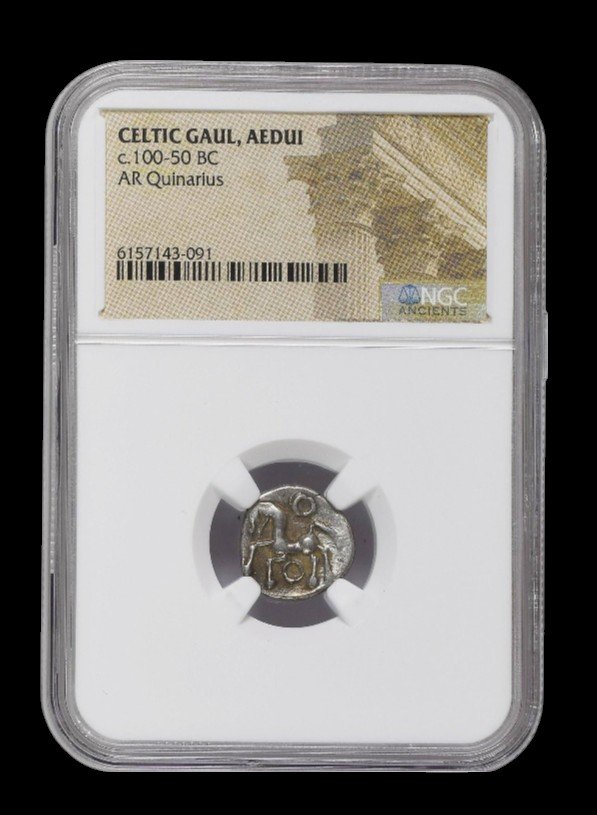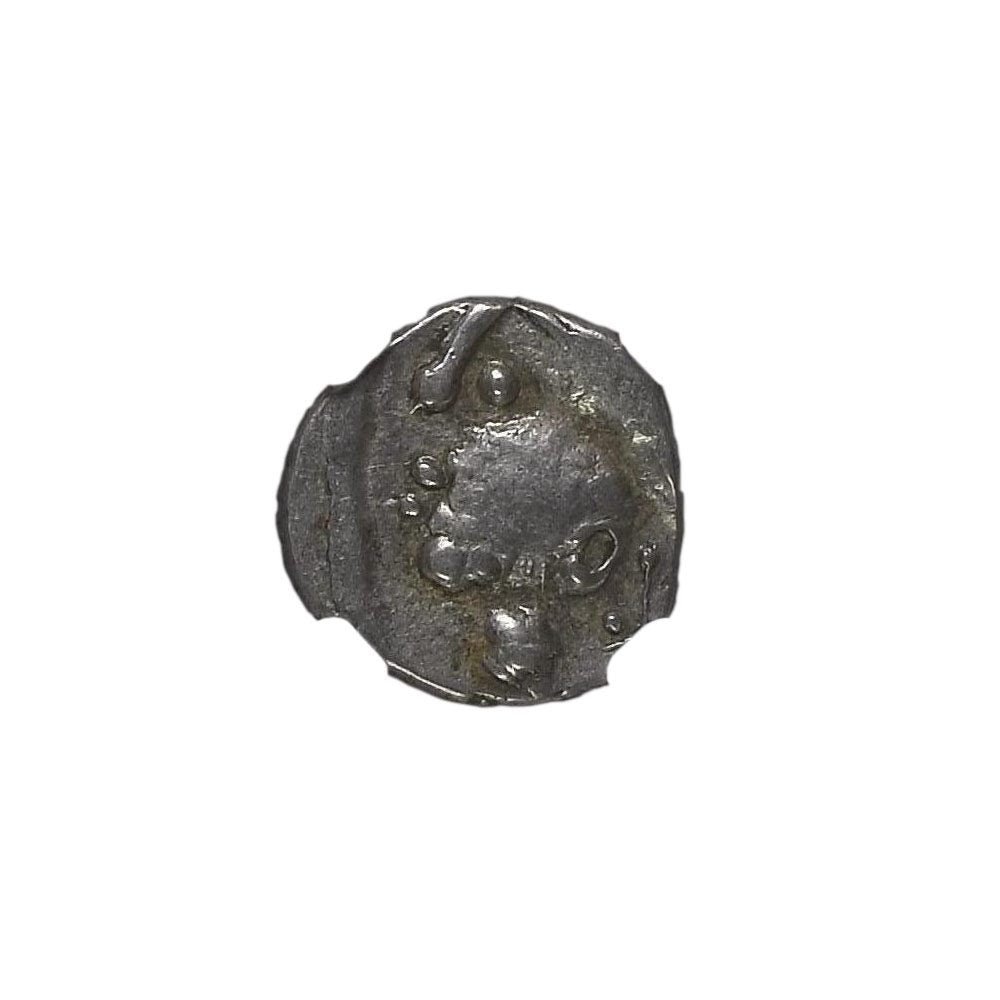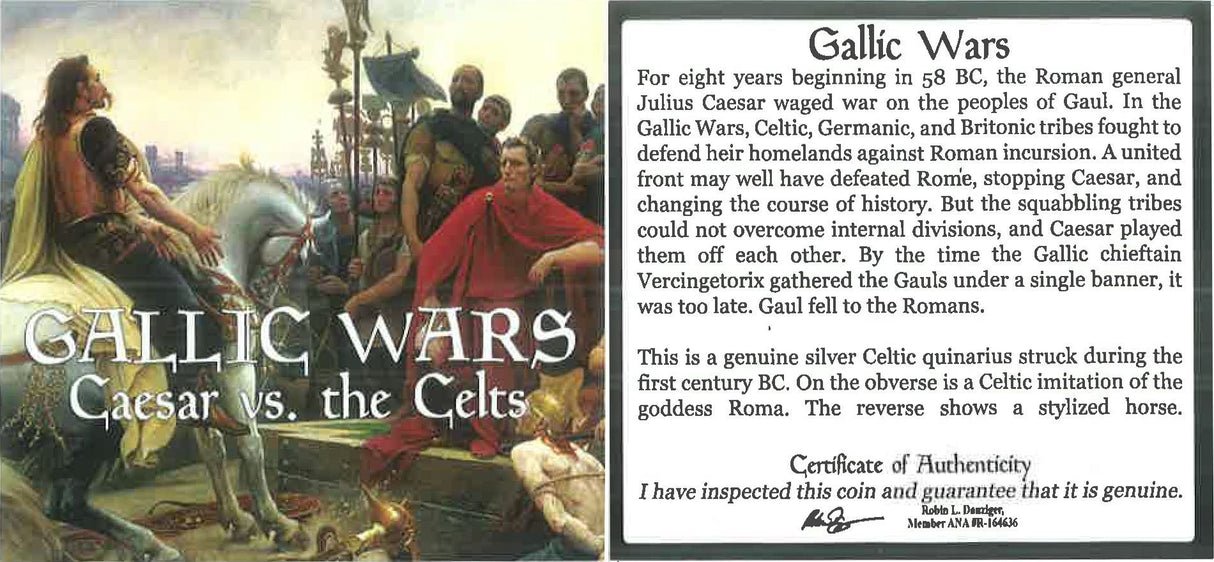 Image 1 of 3
Image 1 of 3

 Image 2 of 3
Image 2 of 3

 Image 3 of 3
Image 3 of 3




Celtic Silver Coin from Pre-Roman Gaul (about 2,075-2,085 years ago)
This small silver coin was produced by Celtic tribes living in ancient Gaul (primarily modern France) shortly before Caesar's conquest permanently altered the region's cultural landscape. The quinarius demonstrates how Celtic peoples adapted and reimagined Greek and Roman coin designs through their own distinctive artistic sensibilities, creating uniquely Celtic interpretations of classical motifs.
Coin Description:
Front side: Likely features a stylized human head or bust with distinctive Celtic artistic elements, potentially based on Greek or Roman prototypes but rendered in the characteristic Celtic abstract style
Back side: Probably depicts a horse, chariot, boar, or other symbolic animal important in Celtic culture, often with additional symbols like wheels, stars, or torcs (Celtic neck rings)
Technical Details:
Silver composition (AR = argentum, silver in numismatic terminology)
Denomination: Quinarius (a small silver coin worth half a denarius in the Roman system)
NGC certified in a slab holder (protective case)
Minted approximately 60-50 BCE, during the late La Tène period
Condition as certified by NGC
Historical Significance: This coin represents the sophisticated monetary system developed by Celtic tribes in Gaul during the decades immediately preceding Roman conquest. Celtic coinage initially emerged as imitations of Greek coins (particularly those of Philip II of Macedon), but evolved into distinctive styles that reflected Celtic aesthetic preferences for abstract, flowing designs. The date range of this coin (60-50 BCE) places it during the crucial period of Julius Caesar's Gallic Wars (58-50 BCE), when Roman armies systematically conquered the region. These coins thus represent the twilight of independent Celtic culture in Gaul, circulating just as Celtic tribal societies were being integrated into the expanding Roman world. The rapid adoption of Roman customs after conquest makes these coins important artifacts of pre-Roman Celtic civilization, demonstrating their advanced economic systems and artistic achievements before their absorption into Roman provincial culture.
This small silver coin was produced by Celtic tribes living in ancient Gaul (primarily modern France) shortly before Caesar's conquest permanently altered the region's cultural landscape. The quinarius demonstrates how Celtic peoples adapted and reimagined Greek and Roman coin designs through their own distinctive artistic sensibilities, creating uniquely Celtic interpretations of classical motifs.
Coin Description:
Front side: Likely features a stylized human head or bust with distinctive Celtic artistic elements, potentially based on Greek or Roman prototypes but rendered in the characteristic Celtic abstract style
Back side: Probably depicts a horse, chariot, boar, or other symbolic animal important in Celtic culture, often with additional symbols like wheels, stars, or torcs (Celtic neck rings)
Technical Details:
Silver composition (AR = argentum, silver in numismatic terminology)
Denomination: Quinarius (a small silver coin worth half a denarius in the Roman system)
NGC certified in a slab holder (protective case)
Minted approximately 60-50 BCE, during the late La Tène period
Condition as certified by NGC
Historical Significance: This coin represents the sophisticated monetary system developed by Celtic tribes in Gaul during the decades immediately preceding Roman conquest. Celtic coinage initially emerged as imitations of Greek coins (particularly those of Philip II of Macedon), but evolved into distinctive styles that reflected Celtic aesthetic preferences for abstract, flowing designs. The date range of this coin (60-50 BCE) places it during the crucial period of Julius Caesar's Gallic Wars (58-50 BCE), when Roman armies systematically conquered the region. These coins thus represent the twilight of independent Celtic culture in Gaul, circulating just as Celtic tribal societies were being integrated into the expanding Roman world. The rapid adoption of Roman customs after conquest makes these coins important artifacts of pre-Roman Celtic civilization, demonstrating their advanced economic systems and artistic achievements before their absorption into Roman provincial culture.
This small silver coin was produced by Celtic tribes living in ancient Gaul (primarily modern France) shortly before Caesar's conquest permanently altered the region's cultural landscape. The quinarius demonstrates how Celtic peoples adapted and reimagined Greek and Roman coin designs through their own distinctive artistic sensibilities, creating uniquely Celtic interpretations of classical motifs.
Coin Description:
Front side: Likely features a stylized human head or bust with distinctive Celtic artistic elements, potentially based on Greek or Roman prototypes but rendered in the characteristic Celtic abstract style
Back side: Probably depicts a horse, chariot, boar, or other symbolic animal important in Celtic culture, often with additional symbols like wheels, stars, or torcs (Celtic neck rings)
Technical Details:
Silver composition (AR = argentum, silver in numismatic terminology)
Denomination: Quinarius (a small silver coin worth half a denarius in the Roman system)
NGC certified in a slab holder (protective case)
Minted approximately 60-50 BCE, during the late La Tène period
Condition as certified by NGC
Historical Significance: This coin represents the sophisticated monetary system developed by Celtic tribes in Gaul during the decades immediately preceding Roman conquest. Celtic coinage initially emerged as imitations of Greek coins (particularly those of Philip II of Macedon), but evolved into distinctive styles that reflected Celtic aesthetic preferences for abstract, flowing designs. The date range of this coin (60-50 BCE) places it during the crucial period of Julius Caesar's Gallic Wars (58-50 BCE), when Roman armies systematically conquered the region. These coins thus represent the twilight of independent Celtic culture in Gaul, circulating just as Celtic tribal societies were being integrated into the expanding Roman world. The rapid adoption of Roman customs after conquest makes these coins important artifacts of pre-Roman Celtic civilization, demonstrating their advanced economic systems and artistic achievements before their absorption into Roman provincial culture.
Gaul (Latin: Gallia)[1] was a region of Western Europe first clearly described by the Romans, encompassing present-day France, Belgium, Luxembourg, and parts of Switzerland, the Netherlands, Germany, and Northern Italy. It covered an area of 494,000 km2 (191,000 sq mi).[2] According to Julius Caesar, who took control of the region on behalf of the Roman Republic, Gaul was divided into three parts: Gallia Celtica, Belgica, and Aquitania.
Archaeologically, the Gauls were bearers of the La Tène culture during the 5th to 1st centuries BC.[3] This material culture was found not only in all of Gaul but also as far east as modern-day southern Poland, Slovakia, and Hungary.
Warbands led by the Gaul Brennos sacked the city of Rome in 387 BC, becoming the only time Rome was conquered by a foreign enemy in 800 years. However, Gallia Cisalpina was conquered by the Romans in 204 BC and Gallia Narbonensis in 123 BC. Gaul was invaded after 120 BC by the Cimbri and the Teutons, who were in turn defeated by the Romans by 103 BC. Julius Caesar finally subdued the largest part of Gaul in his campaigns of 58 to 51 BC. Roman control of Gaul lasted for five centuries, until the last Roman rump state, the Domain of Soissons, fell to the Franks in AD 486.




